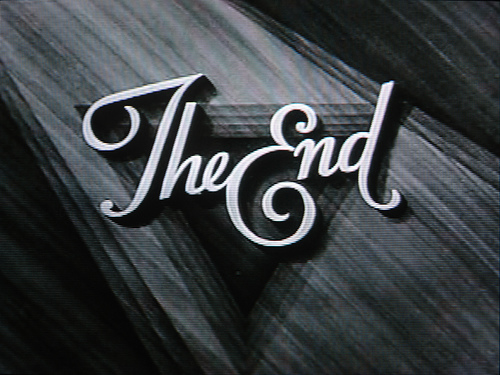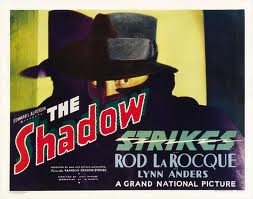 After the three disappointing films released in 1946, The Shadow film franchise would be laid to rest. By 1949, Shadow Comics had ended its run after 101 issues and The Shadow Magazine ceased publication due to a changing environment on the newsstands. The radio program remained strong until its end in 1954. Aside from two failed television pilots in the 1950s, The Shadow was pushed back into the very shadows from which he had emerged in 1930.
After the three disappointing films released in 1946, The Shadow film franchise would be laid to rest. By 1949, Shadow Comics had ended its run after 101 issues and The Shadow Magazine ceased publication due to a changing environment on the newsstands. The radio program remained strong until its end in 1954. Aside from two failed television pilots in the 1950s, The Shadow was pushed back into the very shadows from which he had emerged in 1930.
As with any good hero, The Shadow waited for the perfect time to return. In 1964, Archie Comics published a new costume-wearing version that only lasted eight issues. There were new novels in the 60s and radio stations began playing the old programs to a new audience. By the 70s, DC Comics had the publishing rights and brought The Shadow into the DC universe with not only his own 12-issue series but appearances in Batman and Detective Comics as well. More comic book series followed in the 80s but The Shadow was still missing from the big screen. That changed with the release of The Shadow in 1994.
Screenwriter David Koepp was hired to write the screenplay in 1990. Having been a childhood fan of the radio program, he tried to capitalize on aspects of both the pulp novels and the radio program. Alec Baldwin was cast in the lead role of Lamont Cranston aka The Shadow. Long before his television resurgence on 30 Rock and the constant battles with the paparazzi and his ex-wife, this was a time when Baldwin was still a rising star in Hollywood with such films as Beetlejuice, The Hunt for Red October and Malice. Yet, his ever present sarcasm and screen wit are here, contributing to what I think was a very good performance. His Lamont is a playboy in the mold of Bruce Wayne while displaying the inner conflict between his good and evil sides. On the flip side, Penelope Ann Miller played Margo Lane in a way that over-accentuated her sexuality, not quite the Margo I’ve envisioned. Not to mention the fact that she has telepathic abilities that, while contributing to the script, was not necessarily a wanted addition to her character.
 The plot of The Shadow (1994) was by far the best visualization the character ever had on the big screen. From the opening scenes in Tibet, where we see Cranston as a drugged out warlord succumbing to his dark side, to the film noir visuals of New York City where he is now a “wealthy young man about town”, the film is a visual feast. It captures styles we had already seen in two other comic book films, Batman (1989) and Dick Tracy (1990), and it works very well here. Cranston is given a legitimate arch villain to battle in the evil Shiwan Kahn (John Lone), who is much like The Joker to Cranston’s Batman. Shiwan tries to lure Cranston to the dark side while he has dreams of global domination, following in the footsteps of his ancestor Genghis Kahn. Add to the mix scientist Reinhardt Lane (Ian McKellan, The Hobbit and X-Men) and his atomic device, and you have the elements all in place for a battle of wits and mental skills with the innocent New Yorkers at risk of annihilation.
The plot of The Shadow (1994) was by far the best visualization the character ever had on the big screen. From the opening scenes in Tibet, where we see Cranston as a drugged out warlord succumbing to his dark side, to the film noir visuals of New York City where he is now a “wealthy young man about town”, the film is a visual feast. It captures styles we had already seen in two other comic book films, Batman (1989) and Dick Tracy (1990), and it works very well here. Cranston is given a legitimate arch villain to battle in the evil Shiwan Kahn (John Lone), who is much like The Joker to Cranston’s Batman. Shiwan tries to lure Cranston to the dark side while he has dreams of global domination, following in the footsteps of his ancestor Genghis Kahn. Add to the mix scientist Reinhardt Lane (Ian McKellan, The Hobbit and X-Men) and his atomic device, and you have the elements all in place for a battle of wits and mental skills with the innocent New Yorkers at risk of annihilation.
The Shadow is finally seen on screen as he should be. From the sinister laugh to the fedora and red scarf to his side arms and flowing cape, Baldwin really works here as The Shadow. His invisibility is great, including the wonderful scene where his footprints are visible in the water tank. Besides the great visuals, the supporting cast makes this movie even more fun. Johnathan Winters is Wainwright Barth (why they just didn’t call him Commissioner Weston is a bit of a mystery), Sab Shimono is Dr. Roy Tam (an agent of The Shadow pulled right out of the pulp novels), Peter Boyle (Young Frankenstein) is cabbie Moe Shrevnitz aka Shrevvy and Tim Curry is the annoying Farley Claymore, putting in a somewhat uneven over-the-top performance. And, of course, I must mention the great music of Jerry Goldsmith, who adds atmosphere to a film already dripping with it.
I thoroughly enjoyed The Shadow but that opinion is not held by all. It was intended to be the start of a new film franchise but poor returns at the box office killed that idea. The film has attained a bit of a cult status and just recently had a second and superior Blu-ray release. Not all fans of The Shadow enjoy this film but I think it is by far the best film adaptation to date. Rumors have been circulating of a new film for years but this is a character that I feel is best suited for the past. The only way it would work would be as a period piece. Until such a day arises when The Shadow returns again, this 1994 film is the last and best visual presentation we’ve been given.
Check out the amazing bridge fight scene courtesy of Shout! Factory and do some shopping for the new Blu-ray. Meanwhile, we have one more stop in our Shadow journey this month. Next time, I’ll be looking at a 2011 documentary as well as the current state of the franchise.



















